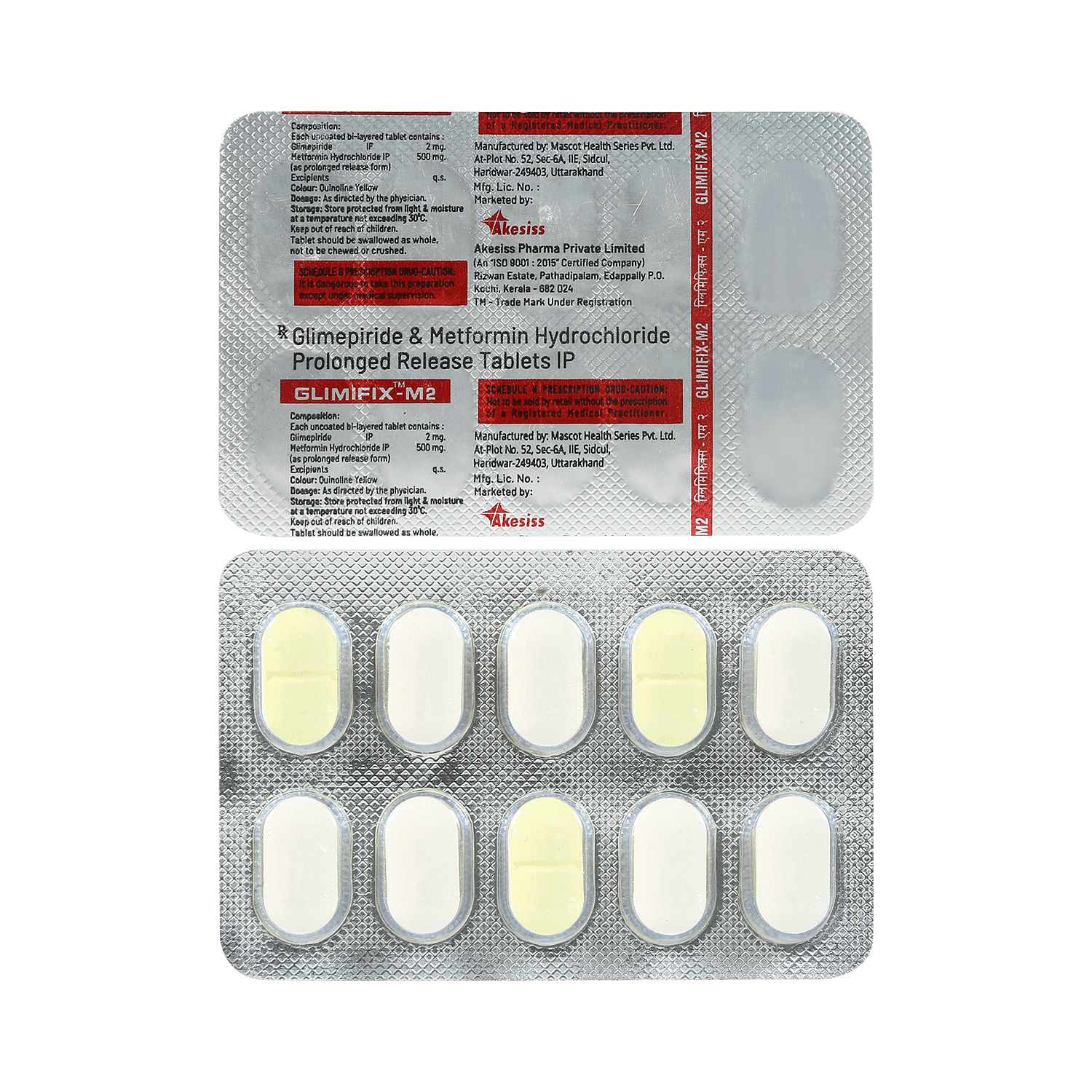
Q Glim M 2mg/500mg Tablet
Manufacturer
Qualchem Healthcare Pvt Ltd
Salt Composition
Glimepiride (2mg) + Metformin (500mg)
Key Information
Short Description
Q Glim M 2mg/500mg Tablet is a combination of two medicines used to treat type 2 diabetes mellitus in adults. It helps control blood sugar levels in people with diabetes.
Dosage Form
Tablet
Introduction
Q Glim M 2mg/500mg Tablet is a combination of two medicines used to treat type 2 diabetes mellitus in adults. It helps control blood sugar levels in people with diabetes. It is a combination of two medicines: Glimepiride and Metformin. Glimepiride is a sulfonylurea which works by increasing the amount of insulin released by the pancreas in order to lower the blood glucose. Metformin is a biguanide which works by lowering glucose production in the liver, delaying glucose absorption from intestines and increasing the body's sensitivity to insulin.
Directions for Use
Take this medicine in the dose and duration as advised by your doctor. Swallow it as a whole. Do not chew, crush or break it. Q Glim M 2mg/500mg Tablet is to be taken with food.
Safety Information
Side Effects
No common side effects listed.
Alcohol Warning
It is unsafe to consume alcohol with Q Glim M 2mg/500mg Tablet.
Breastfeeding Warning
Q Glim M 2mg/500mg Tablet is unsafe to use during breastfeeding. Data suggests that the drug may cause toxicity to the baby.
Pregnancy Warning
Q Glim M 2mg/500mg Tablet may be unsafe to use during pregnancy. Although there are limited studies in humans, animal studies have shown harmful effects on the developing baby. Your doctor will weigh the benefits and any potential risks before prescribing it to you. Please consult your doctor.
How it works
Q Glim M 2mg/500mg Tablet is a combination of two antidiabetic medicines: Glimepiride and Metformin. Glimepiride is a sulfonylurea which works by increasing the amount of insulin released by the pancreas in order to lower the blood glucose. Metformin is a biguanide which works by lowering glucose production in the liver, delaying glucose absorption from intestines and increasing the body's sensitivity to insulin.
Quick Tips
You have been prescribed this combination medicine as it can control blood sugar better than metformin alone. You should continue to exercise regularly eat a healthy diet and take your other diabetes medicines along with Q Glim M 2mg/500mg Tablet. Take it with food to lower your chance of having an upset stomach. Monitor your blood sugar level regularly while you are taking this medicine. It can cause hypoglycemia (low blood sugar level) when used with other antidiabetic medicines, alcohol or if you delay or miss a meal.
Related Medicines

Glucut 2 MT Tablet

Diaprid-M 2mg/500mg Tablet

Glimkap M 2 Tablet

Metsurge GP 2 mg/500 mg Tablet

Glimifix M 2 mg/500 mg Tablet

Zosmet G 2mg/500mg Tablet

Glimex MF 2mg/500mg Tablet

Edmin G 2mg/500mg Tablet

Milliglim M 2mg/500mg Tablet

Zetaglim M 2mg Tablet
Frequently asked questions
What are the recommended storage conditions for Q Glim M 2mg/500mg Tablet?
Store Q Glim M 2mg/500mg Tablet in its original container, tightly closed. Follow the storage instructions provided on the packaging or label. Dispose of unused medication responsibly and ensure it is not accessible to children, pets, or other individuals.
Can the use of Q Glim M 2mg/500mg Tablet lead to lactic acidosis?
Yes, using Q Glim M 2mg/500mg Tablet may result in lactic acidosis, a medical emergency characterized by elevated blood lactate levels. This rare side effect is particularly concerning for individuals with kidney disease, older adults, or those who consume excessive alcohol. Symptoms of lactic acidosis include muscle pain or weakness, dizziness, fatigue, feeling cold in the arms and legs, difficulty breathing, nausea, vomiting, abdominal pain, or a slow heart rate. If you experience these symptoms, discontinue Q Glim M 2mg/500mg Tablet use and consult your doctor immediately.
What is Q Glim M 2mg/500mg Tablet?
Q Glim M 2mg/500mg Tablet is a combination medication consisting of glimepiride and metformin. It is used to treat type 2 diabetes mellitus (DM) in adults, improving blood glucose levels when combined with a proper diet and regular exercise. Glimepiride reduces blood sugar levels by increasing insulin release from the pancreas, while metformin lowers glucose production in the liver and enhances insulin sensitivity. This combination is not indicated for the treatment of type 1 DM.
What are the possible side effects of Q Glim M 2mg/500mg Tablet?
Common side effects associated with Q Glim M 2mg/500mg Tablet include hypoglycemia (low blood sugar level), altered taste, nausea, stomach pain, diarrhea, and headache. Rare but serious side effects may include lactic acidosis. Prolonged use of Q Glim M 2mg/500mg Tablet can also lead to Vitamin B12 deficiency.
Can the use of Q Glim M 2mg/500mg Tablet lead to Vitamin B12 deficiency?
Yes, using Q Glim M 2mg/500mg Tablet may cause Vitamin B12 deficiency on long-term use. This is because it interferes with Vitamin B12 absorption in the stomach. If left untreated, Vitamin B12 deficiency can lead to anemia and nerve problems, manifesting as tingling sensation or numbness in hands and feet, weakness, urinary issues, changes in mental status, and difficulties with balance (ataxia). To avoid these complications, it is recommended to supplement with Vitamin B12 at least once a year.
Can the use of Q Glim M 2mg/500mg Tablet cause hypoglycemia?
Yes, using Q Glim M 2mg/500mg Tablet can lead to hypoglycemia (low blood sugar level). Symptoms include nausea, headache, irritability, hunger, sweating, dizziness, rapid heart rate, and feelings of anxiety or shakiness. Hypoglycemia is more likely when you miss or delay meals, consume alcohol, over-exercise, or take other diabetes medications along with Q Glim M 2mg/500mg Tablet. Regular blood sugar level monitoring is essential.
Is it safe to take alcohol while I am also taking Q Glim M 2mg/500mg Tablet?
No, it is not safe to consume alcohol while taking Q Glim M 2mg/500mg Tablet, as it may lower blood sugar levels and increase the risk of lactic acidosis.


